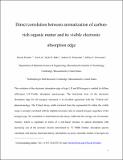Direct correlation between aromatization of carbon-rich organic matter and its visible electronic absorption edge
Author(s)
Bake, Kyle D.; Pomerantz, Andrew E.; Liu, Y.
DownloadGrossman_Direct Correlation.pdf (5.576Mb)
PUBLISHER_CC
Publisher with Creative Commons License
Creative Commons Attribution
Terms of use
Metadata
Show full item recordAbstract
The evolution of the electronic absorption edge of type I, II and III kerogen is studied by diffuse reflectance UV–Visible absorption spectroscopy. The functional form of the electronic absorption edge for all kerogens measured is in excellent agreement with the “Urbach tail” phenomenology. The Urbach decay width extracted from the exponential fit within the visible range is strongly correlated with the aliphatic/aromatic ratio in isolated kerogen, regardless of the kerogen type. No correlation is found between the decay width and the average size of aromatic clusters, which is explained in terms of a non-linear increase in optical absorption with increasing size of the aromatic clusters determined by ¹³C NMR. Further, absorption spectra calculated with density functional theory calculations on proxy ensemble models of kerogen are in excellent agreement with the experimental results. The correlation of the decay width with conventional maturity indicators such as vitrinite reflectance is found to be good within a particular kerogen type, but not consistent across different kerogen types, reflecting systematic variations in bulk composition for different type kerogen types with the same vitrinite reflectance. Thus, diffuse reflectance visible absorption spectroscopy is presented as a rapid, calibrated and non-destructive method to monitor both the maturity and the chemical composition of kerogen. The chemical insight of kerogen in relation to its optical absorption provided by this methodology may serve for rapid screening of kerogen for electronics and optical devices in place of functionalized produced carbon.
Date issued
2015-03Department
Massachusetts Institute of Technology. Department of Materials Science and EngineeringJournal
Carbon
Publisher
Elsevier
Citation
Ferralis, Nicola; Liu, Yun; Bake, Kyle D.; Pomerantz, Andrew E. and Grossman, Jeffrey C. “Direct Correlation Between Aromatization of Carbon-Rich Organic Matter and Its Visible Electronic Absorption Edge.” Carbon 88 (July 2015): 139–147 © 2015 Elsevier Ltd
Version: Final published version
ISSN
0008-6223